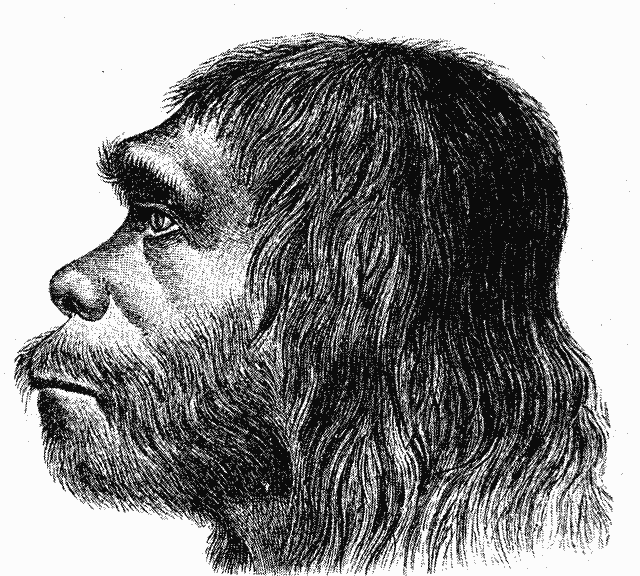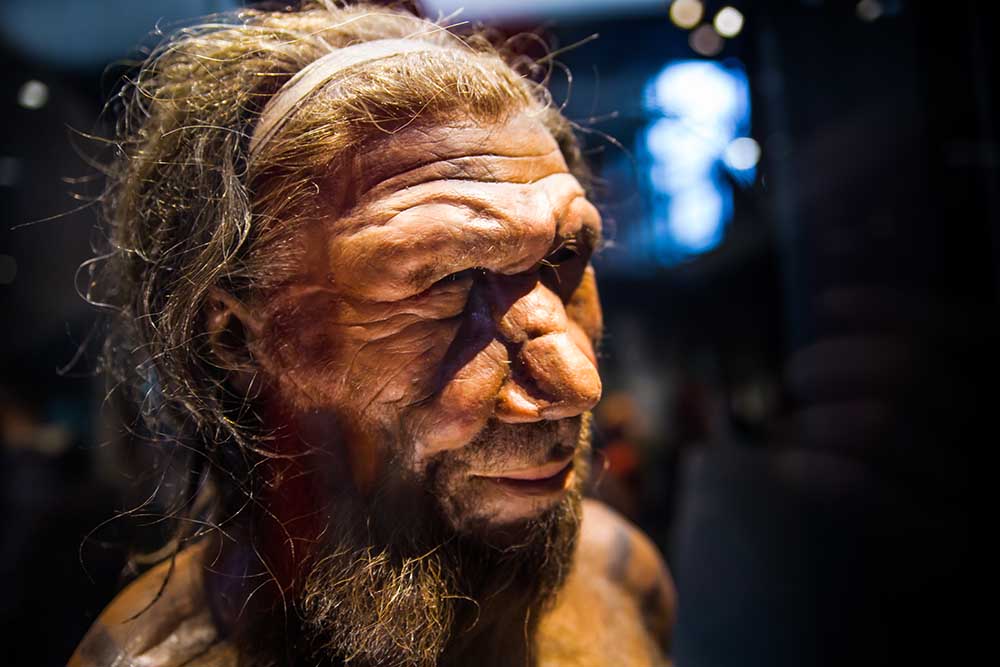Key Points:
- Neanderthals had short, stocky bodies and prominent brow ridges. They were capable tool makers and extremely skilled hunters.
- Though Neanderthals existed at the same time as homo sapiens, they went extinct around 40,000 years ago.
- The average height of modern humans is 5ft 9in for men and 5ft 4in for women. Neanderthals, on the other hand, reached an average height of 5 feet and 5ft 6ins.
Neanderthals are an extinct species of ancient humans who lived 350,000 to 40,000 years ago, while homo sapiens are modern humans. For a long time, many people believed that we evolved from Neanderthals, but they’re actually one of our most recent relatives and lived alongside early humans. For a long time, Neanderthals were depicted as brutish cavemen who walked with a hunch and wielded clubs. The term has even been used as an insult for many of the same reasons. However, the truth is there is much more to Neanderthals than initially thought. So, just what are the differences between the two? Join us as we discover exactly how different Neanderthals and homo sapiens really are!
Comparing Homo sapiens vs Neanderthal
Neanderthals (homo neanderthalensis) are known for their short, stocky bodies and prominent brow ridges. They were capable tool makers and extremely skilled hunters. On the other hand, homo sapiens means “wise man” which is particularly apt given how much we have adapted and achieved. Although there is a common misconception that Neanderthals are our ancestors, they are actually just a really close relative. But just how close are they?
Check out the chart below to learn a few of the main differences between homo sapiens and Neanderthals.
| Homo sapiens | Neanderthal | |
|---|---|---|
| Status | Alive | Extinct – lived 350,000 to 40,000 years ago |
| Location | Worldwide – in a variety of climates and conditions, highly adaptable | Eurasia – often in cold and arid conditions |
| Height | Varies depending on factors such as country and living conditions. Expected average is 5ft 9in for men and 5ft 4in for women | Average 5 fet to 5ft 6in |
| Limbs | Long limbs | Short limbs, particularly lower legs and lower arms |
| Chest | Normal shaped | Barrel shaped |
| Bones | Thinner and not as robust as those of early humans, narrower pelvis | Thick, strong bones and wide pelvis |
| Humerus | Symmetrical | Asymmetrical |
| Metacarpals | Thinner | Thicker |
| Skull | More rounded skull, no prominent brow ridge | Elongated skull, stretched from front to back. Prominent brow ridge above the eyes, large wide nose |
| Teeth | Smaller teeth than those of early humans. Two equal-sized cusps in lower premolars | Larger front teeth, larger roots, and enlarged pulp cavities in molars. Teeth developed quicker |
| Lifespan | Varies depending on country, living conditions etc World average is 70 for men and 75 for females | Around 80% died before the age of 40 |
The 5 Key Differences Between Neanderthals and Homo sapiens
Neanderthal vs Homo sapiens: Skull

Neanderthals had a different shaped skull and prominent brow ridges
©Hermann Schaaffhausen – Public Domain
Easily one of the most obvious differences between Neanderthals and homo sapiens is the differences in their skull and facial features. Homo sapiens have a typically round-shaped skull while the Neanderthals’ skulls are much more elongated from front to back. This longer skull was to allow for the larger brain that Neanderthals had. Additionally, neanderthals had a prominent brow ridge above the eyes. They also had a much larger nose. The nasal passageways were noticeably larger than those of homo sapiens. This is thought to have been to provide an increased oxygen intake while doing strenuous activity in particularly cold environments. Neanderthals also had a less noticeable chin than homo sapiens, but a more sloped forehead.
Neanderthal vs Homo sapiens: Height
Today, the height of homo sapiens varies depending on factors such as country, living conditions, gender, race, etc. However, on average humans today are still taller than Neanderthals. The expected worldwide average is 5ft 9in for men and 5ft 4in for women. Yet, neanderthals were somewhat smaller, and on average most were between 5 feet and 5ft 6ins. This height difference can in part be attributed to the shorter limbs of Neanderthals. Neanderthals had shorter lower legs as well as shorter lower arms than homo sapiens, who have much longer limbs.
Neanderthal vs Homo sapiens: Teeth
One of the greatest insights into Neanderthal life comes from their teeth. Neanderthal teeth began to develop much earlier than homo sapiens teeth— in fact, they actually began to develop before birth. Scientists believe that this suggests that Neanderthals actually had a faster growth rate than homo sapiens. The other differences between their teeth include larger front teeth compared to those of homo sapiens, larger roots, a large gap behind the third molar, and enlarged pulp cavities in the molars.
Neanderthal vs Homo sapiens: Bones
Neanderthals and homo sapiens also have different bones. Neanderthals had much stronger and thicker bones than homo sapiens. These thicker bones include thicker metacarpals and generally a more robust disposition which was suited to their harsh lifestyle. They also had an asymmetrical humerus bone as opposed to homo sapiens who have a symmetrical humerus. Neanderthals also had longer and thicker neck vertebrates which would have provided greater stability for their different shaped skulls.
Neanderthal vs Homo sapiens: Body Shape
One of the most distinctive differences between homo sapiens and Neanderthals is the body shape. Homo sapiens—humans today have a normal-shaped chest and a narrow pelvis. Neanderthals had a barrel-shaped chest and a much wider pelvis. Their barrel-shaped chest comprising of longer and straighter ribs possibly allowed for greater lung capacity.

Neanderthals had a short, stocky build with short limbs
©IR Stone/Shutterstock.com
Where did Neanderthals vs Homo sapiens live?
While Neanderthals date from 40,000 years back to 400,000 years ago, homo sapiens existed for a good part of that time, if not as far back. Neanderthals and humans likely evolved from a common ancestor that existed between 700,000 and 300,000 years ago; both species belong to the same genus. The oldest Neanderthal skeleton dates back to about 430,000 years ago and was discovered in Spain. It’s even believed that Neanderthals and homo sapiens shared areas of habitation like Spain and even France before Neanderthals went extinct.
Neanderthals received their name based on one of the earliest archaeological sites where bones were found in the Neander Valley, located in modern-day Dusseldorf, Germany. Researchers have determined that these primitive humans inhabited parts of Eurasia from the Atlantic regions of Europe eastward to Central Asia.
While scientists may struggle with pinpointing exactly how old homo sapiens are, their presence had spread much further than Neanderthals in the period between 200,000 BC and 40,000 BC. Homo sapiens were in Southern and Eastern Africa 200,000 years ago, eventually migrating north and inhabiting Eurasia up to 40,000 BC, Southeast Asia up to 70,000 BC, and Australia up to 50,000 BC.

Neanderthals were named after the Neander Valley near Dusseldorf, Germany, where their remains were first discovered.
©iStock.com/gorodenkoff
FAQ’s (Frequently Asked Questions)
Are Neanderthals and humans the same species?
Neanderthals and humans both belong to the same genus Homo but are not the same species. Neanderthals (homo neanderthalensis) and humans (homo sapiens) are two separate species. Every person alive today is homo sapiens. However, the Neanderthal DNA has been found to exist in some people, meaning that Neanderthals and some early humans actually mated.
Did neanderthals talk?
There has been much speculation over the years as to whether Neanderthals could speak or not. Despite this, recent research has now suggested that they at least had the capacity to speak a language of some sort. Speech is linked to the vocal tract structure and the amount of room at the base of the skull for the pharynx. Neanderthal skull bases have been found to be more arched than chimpanzees, but less arched than humans, which means they were capable of producing some speech, but not necessarily the same range of sounds that humans produce. Despite this, the fact that Neanderthals were skilled toolmakers and proficient hunters shows that they must have been able to communicate effectively.
Were neanderthals intelligent?
Research suggests that Neanderthals were not as dim-witted as they were believed to have been. Along with the evidence that shows they must have been able to speak and communicate effectively, it has been found that Neanderthals buried their dead. There is significant evidence that they marked the graves and made symbolic objects. Additionally, they were able to build and control fires, made tools, and lived in shelters. There is even evidence that they looked after family members who were sick or injured.
Were neanderthals stronger than homo sapiens?
Although it is impossible to know for certain or to what extent, it is generally agreed that Neanderthals were stronger than homo sapiens. The shorter, stockier, and more muscular build of Neanderthals naturally means that they were well suited for strength. In fact, given their tough lifestyle, it’s quite easy to assume that they were pretty strong. Neanderthals were expert hunters and fought with large animals such as mammoths in order to catch and kill them. Not only that, but even after their kill, they would have carried large quantities of meat back to their families.

Neanderthals were incredibly strong as they hunted large mammals such as mammoths
©Esteban De Armas/Shutterstock.com
What did Neanderthals eat?
Neanderthals were predominantly carnivorous and hunted and ate large mammals such as mammoths, elephants, deer, woolly rhinos, and wild boars. However, preserved food found in Neanderthal teeth shows that they also ate some plants and fungi.
Why did Neanderthals become extinct?
Neanderthals became extinct around 40,000 years ago, although their DNA lives on in some humans. The exact reasons for their extinction are unclear. However, some of these reasons are thought to include increased competition from early homo sapiens, as well as interbreeding with them. Moreover, the inability to cope with extreme conditions such as climate change and natural disasters is another reason they went into extinction. The general consensus is that it is unlikely to have been one specific reason that caused their extinction, but rather a combination of many factors.
What’s the Difference Between Humans and Homo Sapiens?
Sometimes it’s necessary to mince words, especially when it comes to scientific accuracy. While we have referred to humans in this article as general “homo sapiens,” technically, modern humans are a sub-species of homo sapiens. Humans would be called “homo sapiens sapiens,” while “homo sapiens” is a broader category.
The definition of homo sapiens is actually “wise human.” But this category not only includes human beings, but also primates–lemurs, apes, lorises, monkeys, and others. The subspecies homo sapiens sapiens became distinctive from general homo sapiens about 160,000 years ago.
The photo featured at the top of this post is © iStock.com/gorodenkoff
Thank you for reading! Have some feedback for us? Contact the AZ Animals editorial team.






